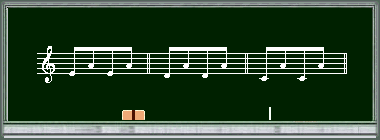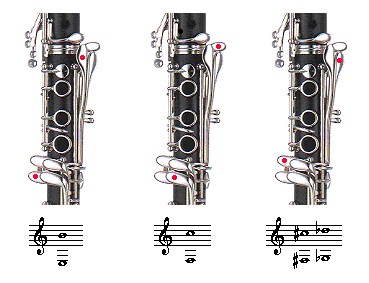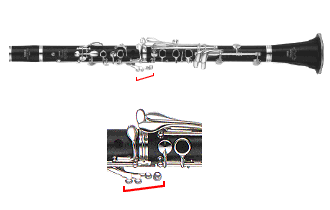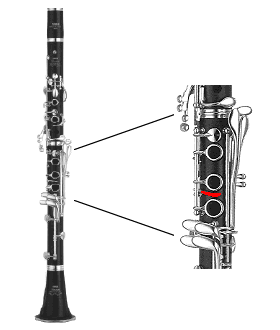The clarinet section is the foundation of the sound of a band. The tone of this part determines the sound of the entire band. Make sure instrument sounds full and rich.
First, learn the fingering for F major and start practicing the scale from top to bottom.

Once students can move up and down, repeat this until they have firmly memorized the image of a smooth scale.
C major scale in a low octave is often practiced at the beginning of an ensemble, but it is fairly difficult for the clarinet.
It is difficult to smoothly move from the B
 , press all fingers together, to the A
, press all fingers together, to the A , which is played by releasing all fingers except the index finger on the left hand and supporting the instrument with only the thumb of the right hand, and if you are not careful, the sound will be interrupted at that point.
, which is played by releasing all fingers except the index finger on the left hand and supporting the instrument with only the thumb of the right hand, and if you are not careful, the sound will be interrupted at that point.
First, repeat E-A with a slur to learn the movement of left index finger. Try to minimize the movement of left index finger when pressing the A key. Once students can do this, practice D-A and C-A in the same way.

Once students can play smoothly with a slur up to C-A, next practice the slur from upper D to A
 without using little finger, then practice upper C to A
without using little finger, then practice upper C to A using little finger. After this preparation, practice B-A
using little finger. After this preparation, practice B-A last.
last. As in the example below, practice the whole notes with a slur, by holding down the B then inserting the A .

Practice holding down the B with the little finger of right hand and keeping right hand hold it down all the time.
By repeating the above exercises in order, students will be able to play the C major scale smoothly, but it is important to first have an image of a smooth connection of notes in the F major scale.
To support the clarinet with just the thumb of right hand is very hard not only for elementary school students but older. This puts strain on the entire right arm, which can affect the finger movements of various other phrases.
If students can place a stand of an appropriate height under the bell to support the weight of the instrument, they will be able to learn the finger movements easier. There are commercially available stands for this purpose, and some people use straps, why don't you try and find something to replace it?
I often hear clarinet parts that sound like screams in the high range. This seems to be due to trying to produce a louder sound and putting too much tension on the embouchure.

Practice playing the lower note of the above and pressing the register key to move to the higher note in same mesure is a good practice to play high notes without unnecessary tension.
However, I think it is most important to first play a quiet melody in a high range before playing in an ensemble and learn (remember) the gentle tone.
The following two points were also of concern in many schools.
The lower three notes (the upper and lower notes have the same fingering except for the register key) can be pressed with either the left or right little finger, but if students only remember one of them, they may not be able to play scales or legato phrases smoothly.

 For these notes, player can use different fingerings depending on the note before and after, but I often see students trying to play everything using only the one fingering they learned at the beginning.
For these notes, player can use different fingerings depending on the note before and after, but I often see students trying to play everything using only the one fingering they learned at the beginning. Please refer to the three cases below for how to use them.
 A If students haven't used the ring finger on the previous note, use the ring finger. Like D to Eb or A to Bb.
A If students haven't used the ring finger on the previous note, use the ring finger. Like D to Eb or A to Bb. B If left ring finger is used on the previous note, use the right index finger to press the Rightmost side key in the figure below.
B If left ring finger is used on the previous note, use the right index finger to press the Rightmost side key in the figure below.
 C Leave the right index finger alone.
C Leave the right index finger alone.
Fingering problems for those just starting to play the clarinet seem to be related to the following two notes (notes above and below have the same fingering except for the register key).

 The key to produce these notes are pressed with the right little finger.
(Some clarinets have a key for these notes on the left hand as well, but this is not common.)
The key to produce these notes are pressed with the right little finger.
(Some clarinets have a key for these notes on the left hand as well, but this is not common.)

 This notes are held down by the left little finger.
This notes are held down by the left little finger.
There are no alternate fingerings for these two(four) notes, so if students remember the simple rule that if there are notes before and after these notes which need the little finger pressing, they can use the opposite little finger to solve many problems.
There are also cases where the left and right little finger slide from key to key, but they can only slide from the inner key to the outer key, and the movement tends to be uncertain, so first teach them to use the left and right little fingers alternately.
By practicing scales and arpeggios(broken chords) in several keys, students will learn which fingers to use depending on the notes before and after. This is another reason why practicing scales and arpeggios is important.
 °°
Otherwise,°°for this kind of note movement (the fingering is the same for the upper and lower notes except for the register keys), the normal fingering is to release the index finger on your right hand and press the middle finger at the same time (or vice versa).
°°
Otherwise,°°for this kind of note movement (the fingering is the same for the upper and lower notes except for the register keys), the normal fingering is to release the index finger on your right hand and press the middle finger at the same time (or vice versa).°°

Instead, you can easily perform trills by pressing the key shown in red in the diagram on the left with the ring finger of your right hand while keeping the index finger pressed.
This key seems to be called the number "5" in France, and the E key or K key in America.
Also,
 for the F-F#-G chromatic scale and F-F# trill, it's easier to finger it by holding down the thumb of your left hand and pressing the bottom two side keys with your right index finger at the same time to play the F#.
for the F-F#-G chromatic scale and F-F# trill, it's easier to finger it by holding down the thumb of your left hand and pressing the bottom two side keys with your right index finger at the same time to play the F#.